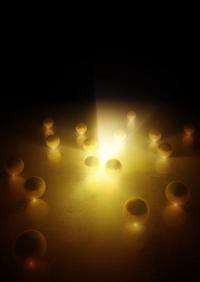Physicists measure photonic interactions at the atomic level

By measuring the unique properties of light on the scale of a single atom, researchers from Duke University and Imperial College, London, believe that they have characterized the limits of metal's ability in devices that enhance light.
This field is known as plasmonics because scientists are trying to take advantage of plasmons, electrons that have been "excited" by light in a phenomenon that produces electromagnetic field enhancement. The enhancement achieved by metals at the nanoscale is significantly higher than that achievable with any other material.
Until now, researchers have been unable to quantify plasmonic interactions at very small sizes, and thus have been unable to quantify the practical limitations of light enhancement. This new knowledge gives them a roadmap for precisely controlling light scattering that should help in the development of devices, such as medical sensors and integrated photonic communications components.
Typically, plasmonic devices involve the interactions of electrons between two metal particles separated by a very short distance. For the past 40 years, scientists have been trying to figure out what happens when these particles are brought closer and closer, at sub-nanometer distances.
"We were able to demonstrate the accuracy of our model by studying the optical scattering from gold nanoparticles interacting with a gold film," said Cristian Ciracì, postdoctoral researcher at Duke's Pratt School of Engineering. "Our results provide a strong experimental support in setting an upper limit to the maximum field enhancement achievable with plasmonic systems."
The results of the experiments, which were conducted in the laboratory of David R. Smith, William Bevan Professor of electrical and computer engineering at Duke, appear on the cover of Science, Aug. 31, 2012.
Ciracì and his team started with a thin gold film coated with an ultra-thin monolayer of organic molecules, studded with precisely controllable carbon chains. Nanometric gold spheres were dispersed on top of the monolayer. Essential to the experiment was that the distance between the spheres and the film could be adjusted with a precision of a single atom. In this fashion, the researchers were able to overcome the limitations of traditional approaches and obtain a photonic signature with atom-level resolution.
"Once you know maximum field enhancement, you can then figure out the efficiencies of any plasmonic system," Smith said. "It also allows us to 'tune' the plasmonic system to get exact predictable enhancements, now that we know what is happening at the atomic level. Control over this phenomenon has deep ramifications for nonlinear and quantum optics."
The Duke team worked with colleagues at Imperial College, specifically Sir John Pendry, who has long collaborated with Smith.
"This paper takes experiment beyond nano and explores the science of light on a scale of a few tenths of a nanometer, the diameter of a typical atom," said Pendry, physicist and co-director of the Centre for Plasmonics and Metamaterials at Imperial College. "We hope to exploit this advance to enable photons, normally a few hundred nanometers in size, to interact intensely with atoms which are a thousand times smaller."
Journal information: Science
Provided by Duke University


















